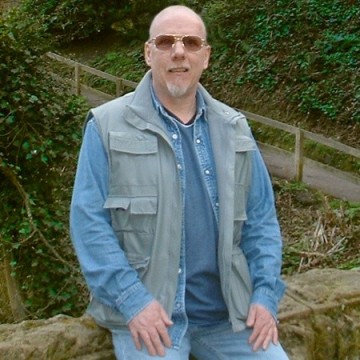 |
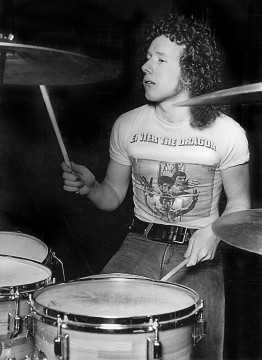 |
|
| Keith Fisher in 2005 | Keith Fisher in the 70s [Island Studios] |
|
Keith Fisher interview |
| by Chris Groom |
| Winter 2005 |
| all photos copyright by Keith Fisher and "the internet" |
|
|
 |
 |
|
| Keith Fisher in 2005 | Keith Fisher in the 70s [Island Studios] |
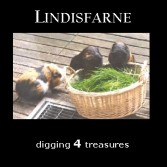 Earlier this year, a
bootleg CD dropped through my door. In amongst the oddities and rareties were five stunning demo tracks from Alan Hull recorded
back in the mists of 1975, with a note to say that they had been supplied by the drummer on those sessions, who had more details and a fascinating story
to tell.
Earlier this year, a
bootleg CD dropped through my door. In amongst the oddities and rareties were five stunning demo tracks from Alan Hull recorded
back in the mists of 1975, with a note to say that they had been supplied by the drummer on those sessions, who had more details and a fascinating story
to tell.
That drummer was Keith Fisher, a stalwart member of the vibrant north east music scene from the late sixties to the present day. Growing up in Heaton, Keith played his first paid gig as a wide-eyed fourteen year old in the winter of 1966, learning his trade with a succession of short-lived groups, playing James Brown tunes and chart hits in front of people who were often more intent on brawling than dancing!
In 1969, Keith was asked by his friend Tom Hill, who had just left the popular local band Sneeze, to join a new outfit with Bob Barton which was to become Blondie, (years before Debbie Harry and her American outfit). As Keith says: "On a local level, Blondie became an instant and resounding success. The talent in the band was both unmistakable and undeniable, but how many times has that meant nothing. No, the kick-start to our success resided in Tom's approach to band promotion. If ever there was a driving force spinning at the centre of an enterprise making a name for itself within the world of music during the late sixties and early seventies here on Tyneside, it was Tom Hill."
Thanks to Tom's ingenious and tenacious approach, Blondie had a full gig diary only six weeks after their first rehearsal, playing every pub, club and dance hall from the Amble British Legion to the Rex Hotel, Whitley Bay.
Around the same time, singer and guitarist Kenny Mountain had been struggling with various incarnations of his band Yellow, line-ups that included guitarist Vic Malcolm (later to co-found Geordie with Tom Hill) and drummer Paul Thompson, who left to join Roxy Music. In August 1970, under pressure from Tom, Kenny agreed to 'adopt' Blondie and the new Yellow was born - Kenny, Tom Hill, Bob Barton, Pierre Pedersen and Keith. Sadly, despite endless trips up and down the motorways and some demos with Decca, Yellow never quite made it, gradually splitting down the centre in a drug-induced haze. With unflinching honesty Keith admits: "with the benefit of hindsight, I can also see that the diligent and tenacious attitude that Tom had fostered at the start of Blondie was now missing from my life. I had become separated from his enthusiastic and realistic approach, drifted down the dead-end-street of a dope inspired dream-world and lost the plot completely."

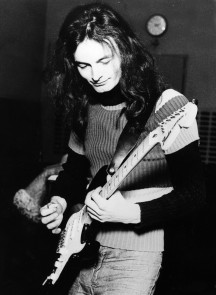 Right at the death of 1972, Keith got a call from Kenny Mountain
[right] to say that
he had a record and publishing deal lined-up, decent management and was looking for a drummer and a bass player. Keith nominated Frankie Gibbon as
his bassist of choice and they joined Beckett on New Years Day, 1972. Along
with Kenny on second guitar and backing vocals, Beckett now consisted of Terry Wilson-Slesser as lead vocalist and Arthur Ramm, lead guitar, plus the
new rhythm section of Frank and Keith.
Right at the death of 1972, Keith got a call from Kenny Mountain
[right] to say that
he had a record and publishing deal lined-up, decent management and was looking for a drummer and a bass player. Keith nominated Frankie Gibbon as
his bassist of choice and they joined Beckett on New Years Day, 1972. Along
with Kenny on second guitar and backing vocals, Beckett now consisted of Terry Wilson-Slesser as lead vocalist and Arthur Ramm, lead guitar, plus the
new rhythm section of Frank and Keith.
Under the watchful eye of promotor Geoff Docherty, Beckett became one of the hardest working bands in the north-east and toured country-wide supporting the likes of the Sensational Alex Harvey Band, Ten Years After and Captain Beefheart & The Magic Band.
Catching the attention of Docherty was key, as Keith points out, "this man had a direct line to every rock god on the planet. He was THE promoter in the north and had brought every band in the world worth watching to his venues in Sunderland and Newcastle. If Geoff said the band was good, every music-industry executive in the country would believe him, such was their respect for his reputation. It was no wonder Beckett had signed such privileged deals."
The band released a single 'My Lady' (Raft/Lyntone LYN 2842) in November 1973 and recorded one album for the Raft label in 1974, produced at Island Studios by Family vocalist Roger Chapman - "the same studios where later, during the recording of the third Crawler album, Terry and I spent our down-time playing football in the car park with Bob Marley!"
Various personnel changes saw Arthur replaced by Bob Barton and Frank Gibbon exit - "we were halfway through recording our album and Bryan Ferry - who was in the same studio doing overdubs on his solo album - heard Frankie playing and offered him the job in Roxy Music; at which point Geoff sacked him, without a by-your-leave from the band" - to be replaced by Ian Murray. Tim Hinckley was brought in to play keyboards on the album. Keith and Bob were next to the leave the band; Barry Black from the John Miles Set taking over the drum stool and Arthur coming back in on guitar. Vocalist Terry Slesser later moved on to join Paul Kossoff in Back Street Crawler.
 |
| left-right: Keith Fisher, Bob Barton, Terry Slesser, Kenny Mountain, Ian Murray |
The Impulse Sessions
Keith's first hand memories of these sessions needed no editing. Remember that these demos were laid down several years before the songs officially appeared on record - and fortunately for us the tapes exist and can be heard on the Digging 4 Treasures bootleg. Sit back and picture the session and wish you had been a fly on the wall!
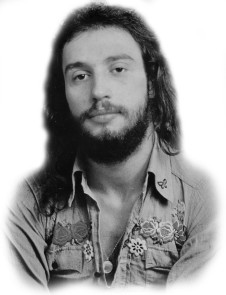 "In the summer of 1975 I got a call from my mate Bobby Barton
[left] to say that
Alan Hull was in need of a drummer, to lay down backing-tracks for some demos he was doing. It didn't pay anything, but it would be satisfying. I
had never met Alan; the folk-world held us "rockers" in slight disdain, understandably.
"In the summer of 1975 I got a call from my mate Bobby Barton
[left] to say that
Alan Hull was in need of a drummer, to lay down backing-tracks for some demos he was doing. It didn't pay anything, but it would be satisfying. I
had never met Alan; the folk-world held us "rockers" in slight disdain, understandably.
Bob had become acquainted with Alan earlier that year and discovered they had both grown up in Benwell. A friendship was born; Bob even wrote a song about it, called 'A Benwell Lad', and dedicated to Alan. It was recorded on a label created by Barry McKay - who was managing Bob at the time - and released locally. As far as I am aware, this was how Barry first got involved with Lindisfarne. Barry had actually been managing an attempt by Bob and myself to form a band after we left Beckett; but I drifted away, realising that we were never going to achieve any satisfactory results with the band anyway. Bob and Barry stayed with it. Bob was a bit pissed-off with me, so he recorded the drums on 'Benwell Lad' himself, but realised he needed a little bit more for the 'Drinking Song' track and asked me to play on it.
Alan had asked Bob to help him out with some demo sessions, and also to suggest a drummer who might be interested in playing on them; for nothing! As I was well acquainted with the stairs into Impulse - and this was to be purely a labour of love - I decided to use the studio kit, augment it with my cymbals and snare, and then rely on Mickey Sweeney's magic. (Impulse Studios are the dressing rooms of a Victorian Music Hall in Wallsend. The auditorium was given a false ceiling and turned into a bingo hall; but no-one wanted a cascade of little rooms connected by thousands of stone stairs, until Dave Wood saw their potential in the early sixties.) Bob was playing electric and acoustic guitars; Alan was on acoustic, keyboards and bass. One of Dave Wood's endless succession of 'Youth Training Scheme' hopefuls was in charge of tea and beer and fish and chips. Obviously Mickey Sweeney was on the desk.
Walk in the Sea had been the doodling favourite of keyboard player Pierre Pedersen, who had worked with Bob and I in Blondie and Yellow a few years previously. Pierre used to play it on his Hammond; Bob and I always found it entrancing. Bob suggested that Alan try it with a Hammond and twin acoustics, just for fun. Actually, it was three acoustics; my mate Kenny Mountain (the main songwriter in Beckett) reminded me that he was also playing acoustic guitar along with Alan and Bob on that track. He had called into the studio and found us there and simply joined in on that song and knowing this, I can now hear Kenny's guitar quite clearly, his is the flamenco style strumming. In a typically Hully approach to fun, he added a recorder, and Bob added the drowning tambourine. The second vocal and celestial choir is Bob. 'A walk in the Irish Sea' was a Spike Milligan paraphrase. I simply sat with Mickey and lapped (sorry) it all up !
Evening was my grooveI was transported by the song. Hearing it for the first time, Alan simply strumming it out on an acoustic, I felt the rhythm pulse as an undercurrent behind his guitar, and he let me run with it. We laid it down with just two acoustics and drums, then Alan added the bass guitar. The photo is Alan laying down the overdubbed bass (under strict canine supervision). Revel in Bob's sublime multi-tracked leads. Most of all, that vocaloooh bliss !
Raw Bacon What a title! What a sentiment! Listen to that stomping, early morning bass line: grumpy and pedantic! Again, added after the drums had been laid down, so that Alan could give me the acoustic as a guide. A savage song, brutally played, particularly those lead guitars, then dismissed with a cursory and derogatory "I don't want to sing anymore".
Somewhere Out There Listen and marvel at Bob's glorious multi-tracked guitars echoing Alan's piano phrases on this track; then that solo at the end - this was Alan's turn to sit at the desk and drool in pleasure.
Judgement Day was a problematic sessionAlan had to get the opening vocal line overdubbed with no timing cue; I can't remember why there was no guide-vocal recorded with the backing tracks, maybe Mickey can. The backing vocal and sax is from Joy Askew. What about those two acoustics! Alan and Bob had a scintillating affinity when it came to acoustic guitars.
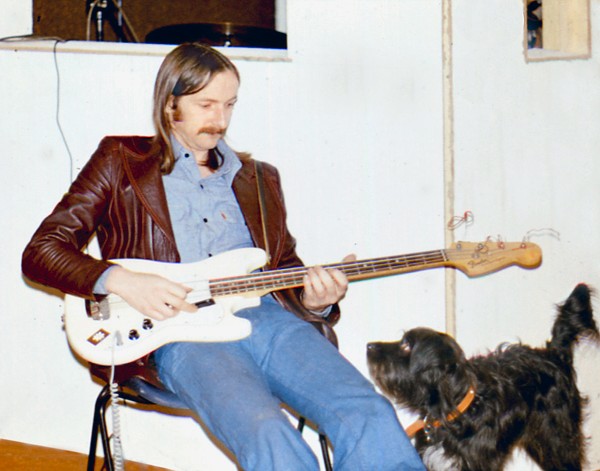 |
| Alan laying down the overdubbed bass for "Evening" (under strict canine supervision). |
I've coveted the cassette Mickey made me of the rough mix. Fortunately there was still some oxide left by the time I came to copy it to CD. I've tried in clumsy fashion to tidy up the resulting digital copy, but it really needs the master copies - that Alan eventually took home - to do justice to the sessions.
There was another session that I played on that same year, and for the same group of demos; but as I never got a rough-mix cassette, I'm afraid I have very little recollection of the songs. I do remember that Terry (Morgan) was there playing bass, and that Bob was not there; but all else is a blur. (This is not an unusual occurrence I'm afraid, there are a mass of 'drug-dug, deep black holes' in my memory, and this is simply one of them).
Actually, one other incident from that session does spring to mind: Alan had asked me to go in to replace the drum tracks on some earlier demos. Apparently the drummer - who Alan graciously did not name, but I knew anyway (obviously not Ray) - had deviated so far from the essence of the song that the tracks were unusable. Initially we attempted to replace the drums, but as anyone who has tried this will tell you, it was impossible. (This was long before the dreaded 'click-track' came along of course; making problems like that disappear, but robbing the music of half of it's soul in the process.) We decided to re-record the backing tracks. I must find out what tracks they were, and try and get a copy of them for my archive.
I was at Alan's house on the New Year's Eve that year, along with Bob and assorted friends and associates (Alan 'Bumper' Brown, of Chosen Few fame, was the 'First Foot') and we sat and listened to the spool copies of the demos that he had brought home; all of us smugly content with the results. Then while Alan went and got more beer from the kitchen, he asked me to put anything on the Hi-Fi to keep the atmosphere going. I chose Lennon's second album (Imagine) and Alan shouted through as the first song kicked in: "Yer bastard, wait till I re-do my stuff on 32 track machines, then we'll see'.
Although I never knew Lennon personally, given what I've learned about him second-hand, I would say that he and Alan were cast from the same mould. I jetted off to Australia a few months afterwards. A succession of women, bands and countries later, it was 1993 before I finally settled back on Tyneside and was able to renew my friendship with Alan. I had ended up in North Shields as it happened, so conceive my astonishment when I discovered that he had moved from Whickham and was living two minutes away from me. I was his 'First-Foot' on New Years Eve of that year; a poignant moment for me, parenthesising the beginning and the end of my worldwide gallivanting.
I know that all I did was play on some locally recorded and unreleased demos, but that was not where the magic and satisfaction came in; that was from sharing in the creative process with a craftsman of words and music, and a very special guy. There are a lot of musicians out there who believe themselves to be songwritersthey are not! Alan was a songwriter to the core, he couldn't help it. I once asked him how he conjured the muse; he told me that a small quantity of drink would open the door, but one drink too many would close it again. The secret was knowing when to stop; the difficulty was managing it."
So there you have it, Keith Fisher's personal insight into a fascinating moment in time taken from his "autobiographical scribbles", an ongoing project to get his thoughts and musical exploits down on paper, before the old memory finally gives out. Ongoing, because Keith is still working hard, juggling at least three bands at any one time - Faith Healer and Rattlesnake Road which both include guitarist Phil Armstrong, a long-time compadre of Steve Daggett, and the sixties-influenced Urban Spacemen. From time to time, Keith has also been known to sit behind the kit for Morgan Le Fay.
My thanks to Keith for his time, patience and invaluable input.
Chris Groom